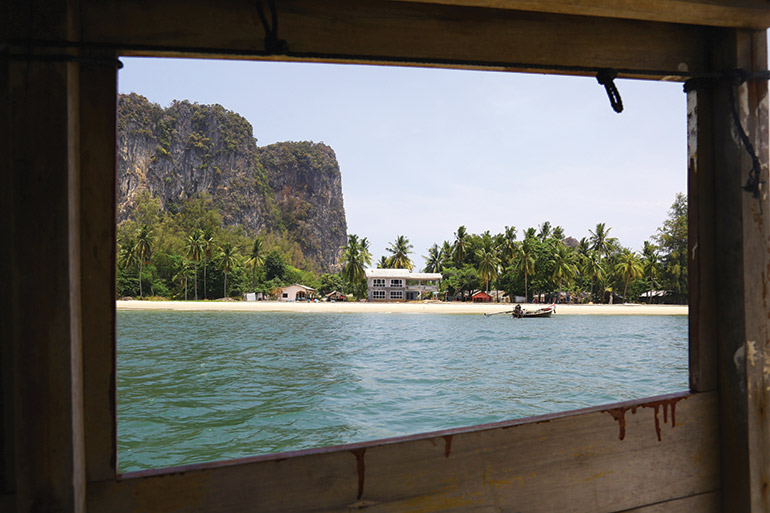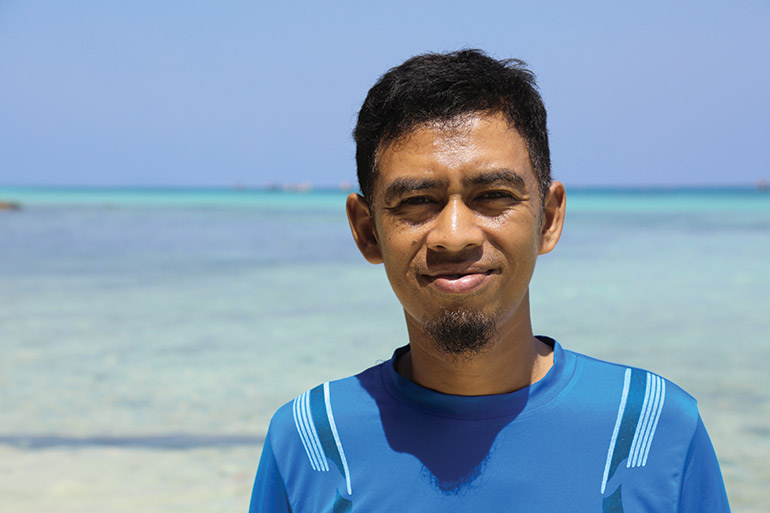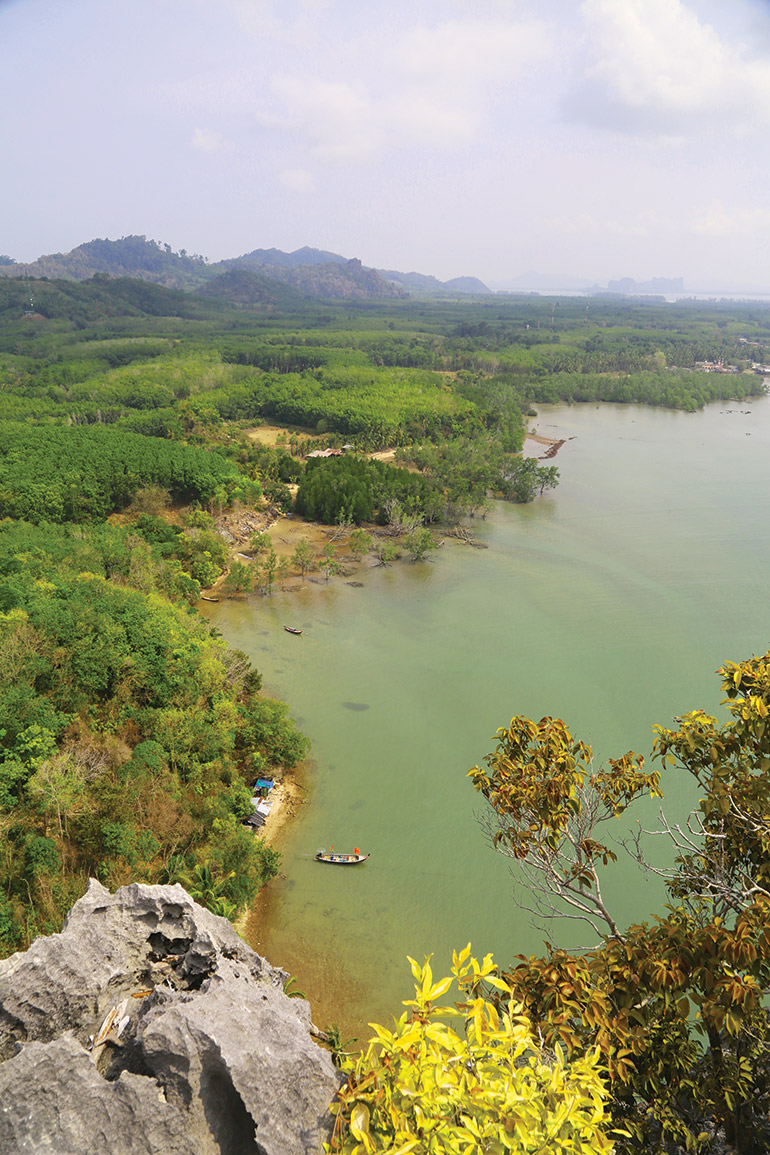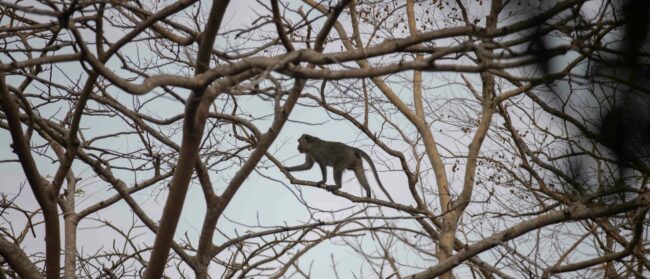“We’re looking for a brown colour, like this,” says local guide Suriya Hadden, patting his hand on a plank of wood. It’s going to be a tough ‘spot’. Even though the summit of White Rock on the Trang island of Koh Libong is better known as Dugong Point, the likelihood of seeing an actual dugong is far from guaranteed. The viewing platform we’re standing on is 150 metres above the ocean. From up here, even with binoculars it’s hard to tell if a dark shape is one of the rare sea cows or just a shadow.
Thailand’s Trang islands are one of the best places in the world to spot the endangered dugong, one of 16 protected wildlife species in Thailand. “There are around 100 dugong around Libong and the Trang islands,” says Suriya, who prefers to go by his nickname Yad, adding that the abundance of seagrass makes this a good place for dugongs to graze.

Swallows loop around the limestone cliffs. The forested peaks behind us on Libong were once used by Japanese soldiers as a vantage point when they occupied the islands in World War II, Yad informs me, miming the action of sniper fire. We watch and wait – without success.
Here, there’s not a single other tourist. Such peace, space and an absence of crowds are par for the course in the Trang islands
It’s difficult to feel bad, though. Not when the journey up to the summit was so enjoyable, hiking along a cool forest trail, navigating a maze-like system of caves, pulling ourselves up cliffs on wooden ladders, and climbing over craggy volcanic rock. And the view is ample reward, the platform looking out across the forested island and along the coast of Libong, including the mosque and pier at the village of Na Baan. Across the shining ocean, there are several more islands. “All of these are Trang islands,” says Yad, proudly.
Anywhere else, a cool hike and an exceptional viewpoint such as this would likely be mobbed. Here, there is not a single other tourist. Such peace, space and an absence of crowds are par for the course in the Trang islands. Other Thai islands, from Phuket to Koh Tao, can sometimes feel overrun with the 30 million international visitors that hit Thailand each year, but, though well known by mainland Thais, only 171,498 foreigners come to the little-known, sparsely populated Trang islands. The sprawl of about 44 islands off southern Thailand’s largely Muslim west coast have a reputation for being like the ‘Thailand of old’: a classic island experience, but without boozed-up Full Mooners, sleazy girly bars or market stalls selling Singha T-shirts. The pace is slower; the prices are generally lower. There’s a notable absence of big chain hotels and resorts. What you do get, instead, is plenty of beautiful beaches, forests and warm, crystalline ocean to explore. And, sometimes, dugongs.
“The Trang islands are very quiet, compared to Koh Lanta, Phuket or Samui,” local tour operator Ekkachai Binwaha tells me on my first morning, as we board a tourist board out to the islands from Pakmeng pier. “Phuket is very famous. Krabi has an international airport, so it gets lots of tourists. We have beautiful islands, but people focus on other places. Many people don’t know about Trang.”
One reason the Trang islands are not so famous, he suggests, is because the islands and mainland coastline are protected as part of Hat Chao Mai National Park, meaning it’s difficult to build hotels and resorts here and to develop tourist infrastructure. “People come to Trang who are looking for a quiet place, people who don’t like Phuket and crowded places. They’re explorers. It’s more adventurous here.”

It’s easy to see the charm of this southerly region, sailing across the rolling Andaman Sea, passing longtail fishing boats and limestone karsts jutting out of the water. We reach one of Trang’s most popular day trips, Morakot cave (or Emerald cave) on Koh Mook, where steep cliff walls surround a small lagoon. “Local people come here first for the bird’s nests, which are sold and used for soup,” Ekkachai informs me. “They’re very valuable.” The hidden cave was also previously used by pirates to stash their treasure, he claims.
Our boat motors on, stopping for snorkelling off Koh Kradan, “the most beautiful beach in the Trang islands”, according to Ekkachai. It looks as if it can live up to that claim, and the water above the coral is busy with bright yellow, blue and silver fish.
When the boat drops me ashore at Koh Hai for the night and the day-trippers head back to the mainland, the islands truly start to work their magic. The sky and ocean turn slowly pink. Local men paddle out on kayaks to fish. Longtail boats rest on the shore. Children play in the warm, shallow water. It would be impossible to ignore the instructions on the sign at a local beach bar: “Kick back, relax!”
Time on the islands develops a rhythm: catching a longtail each morning from a beach to head out to explore, the adventure-filled days ending each evening with a small number of locals and tourists gathering to watch colourful, calming Trang sunsets. For me, the next morning heralds a return to Koh Mook, meeting guide Taord Bangjak – nicknamed Ood – to pick up kayaks from Farang Beach and head out on the choppy seas. “Yesterday had very big waves: boom, boom, boom,” Ood says with a smile. “Today’s better.”
Black rocks close to the cliffs are battered by waves as we paddle up the west coast of the island. Ood knows all the local boatmen, stopping regularly for
a quick chat, usually coming away with a couple of cigarettes. Two hours later, we paddle past a line of palm trees on the approach to Koh Mook pier, coming in for lunch in the village where women and girls wearing headscarves and men in white taqiyah (prayer hats) run errands on motorbikes. As we eat spicy prawn curry, one of the daily calls to prayer sounds out across the island.
The next morning, the longtail chugs across to Koh Kradan. The snorkelling boats will not arrive for hours. Yad, a dive instructor as well as a guide, leads our roll off the side of the longtail and into the water, descending into a landscape of autumnal fan corals in brown, yellow, orange and red, and long sea plumes rising up from the ocean floor. A surprised stingray disappears across the sand into the deeper water. Yad, with his keen eyes, finds a large, venomous stonefish, well camouflaged against the coral.

The second dive site is Hin Nok, out in the open ocean. Yad drops the anchor at the cluster of black rocks poking above the surface. Around the underwater coral garden, there are puffer fish, swarms of bannerfish and clownfish, an elegant squid and moray eels staring out from their homes in the cracks. As with the first dive, there’s not a single other diver around the site. The quantity of marine life down here, though, is remarkable. Shoals of yellow and silver fish are mesmerising as they move along the coral, their numbers seeming to never end. In waters where divers are a rarity, it feels like the fish are less skittish, too, happy to swim along, close to us. Two puffer fish, for example, come close enough to eyeball me. “Krabi and Koh Phi Phi, Koh Tao… Places like that are much busier,” Yad says. “This is normal here. Very quiet.”
Koh Libong, Trang’s biggest island, is the final stop. We hire a couple of motorbikes to explore Libong, turning off the smooth main road onto a dirt track, following signs for ‘Point Dugong’, where an enjoyable, and tourist-free, ascent to the summit awaits. Without seeing any dugongs from the platform, our descent begins, but Yad is soon gesturing to the edge of one of the cave’s openings overlooking the ocean and pointing to a brown shape far below. From so high above, it’s just a speck, not much to get excited about, but it’s a successful sighting nonetheless.
Next comes Na Baan village, home to a small mosque and numerous stilted houses on the waterfront. Along the pier, local women are shelling fresh crabs over large tubs. We then ride down a narrow forest trail to a “secret beach” that Yad knows. There are a few fishing boats out on the shining water, but the beach is empty. It’s something you get happily used to here in the Trang islands; as beautiful as this place is, it’s ours alone to enjoy.
Essentials
Thai Airways (thaiairways.com) have flights to Krabi from numerous destinations, an hour’s drive from Trang or Pakmeng Pier for boat trips to the islands. It is also possible to fly from Bangkok directly to Trang.
The author travelled with Trang Island Hopping Tour, which arranges excursions and holidays on the Trang islands. See trang-all-tour.com for details.
See tourismthailand.org for more information.


